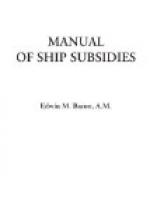By a law of July, 1891, the rates for mail-contract steamships were fixed as follows: for fast lines, making above ten knots, a maximum rate of seventy kreutzers per nautical mile; for slower lines, fifty kreutzers a mile. The total amount of mileage bounty payable each year was limited to two million nine hundred and ten thousand florins. But in addition to this bounty the Government agreed to pay the Suez Canal tolls. To encourage the Austrian Lloyd to build larger and swifter vessels the Government further agreed to advance the company one million and a half florins. This was to be furnished in three equal payments yearly (1891, 1892, 1893), and was to be repaid in five equal payments of three hundred thousand florins each, beginning in January, 1902. The company’s ships were to be exempted from consular fees, “the same as vessels of the imperial navy”; and were to be at the disposal of the naval and military departments in case of war. All the officials of the company were to be Austrian subjects, “naval officers either active or retired to be given the preference”; and there was to be an administrative committee of eight members, the president appointed by the Emperor and two other members by the ministry of commerce, the intention of this provision being to give the Government control over the company’s affairs.[DG]
The general subsidy law of 1893 (November 28) was the outcome of the deliberations of a special Parliamentary committee appointed that year; and its declared object, as set forth in this committee’s report, was “to put a stop to the decline of our merchant fleet, to allow it to cope with foreign competition, and to secure for the inhabitants of our coast needed employment and profits in maritime pursuits."[DG] Three years before (1890), with the same object in view, a preliminary step had been taken in the exemption of all iron and steel steam and sailing ships from trading and income taxes while engaged in ocean voyages.[DG]
The law provided two classes of subsidies—a trade bounty and a navigation bounty. They were to go to all steamers and sailing-ships engaged in the deepseas trade or long-coasting trade, and not receiving mail subventions. At this time a large percentage of the Austrian steam tonnage was receiving the postal subsidies, and most of this tonnage was owned by the Austrian Lloyd Company.[DG] The trade bounty was for ships making long voyages; the navigation bounty for those engaged in coastwise voyaging. Ships entitled to the trade bounty were required to be owned at least two-thirds by Austrian subjects, to be not over fifteen years old, and registered A1 or A2. The rates were thus fixed: for the first year after launching, iron or steel steamers, six florins ($2.44) per ton, iron or steel sailing-ships, four florins and fifty kreutzers; wooden or composite (part iron) sailing-ships, three florins. After the first year the rate was to be reduced five per cent annually till the end of the fifteenth year.




